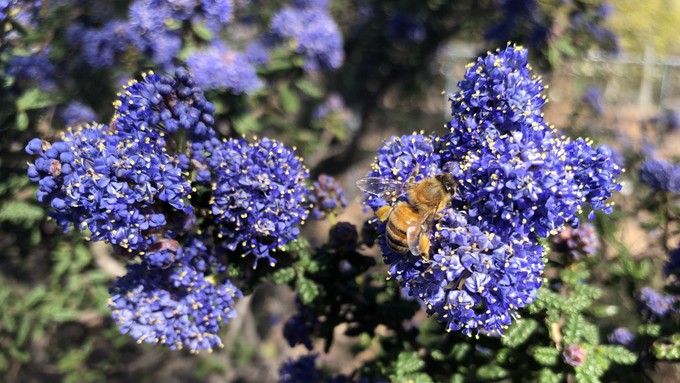
Open Garden Day this month is on Wednesday morning

The ceanothus is in bloom at the Fair Oaks Horticulture Center, and the bees know it. Kathy Morrison
The weather crimped the calendar for plants as well as for people this year. But having experienced some days of sunshine now, the natives and other perennials beginning to bloom, as are the blueberries, the scented geraniums and the fruit trees.
All this botanical activity and more will be on display Wednesday, April 12, when the master gardeners open the gates to the Fair Oaks Horticulture Center for Open Garden Day. The event runs from 9 a.m. to noon and is free to the public.
The Horticulture Center is the showcase for the UC master gardener program in Sacramento County. It features several focus gardens, including an orchard, vegetable garden, herb garden, vineyard, berry garden and compost demonstration area.
The Water Efficient Landscape, in the front of the center, features many native plants and other plants that are water-efficient and appropriate for home gardens. The WEL is open daily, but the other areas are open only during Open Garden days and Harvest Day (that's Aug. 5 this year).
Visitors are welcome to stroll the grounds, be inspired by the plantings and, especially, ask questions of the many master gardeners who will be working in the gardens. The Ask a Master Gardener table will be staffed to help gardeners with their plant problems or mysteries. (Bring samples!)
Additional Open Garden days this spring are scheduled on May 4 (4-7 p.m.); May 20 (9 a.m. to noon) and June 17 (9 a.m. to noon). The Horticulture Center is located at 11549 Fair Oaks Blvd., just south of Fair Oaks Park and Fair Oaks Library off Madison Avenue.
Find more about the Sacramento County master gardener programs and events at sacmg.ucanr.edu.
----
Note: Due to operator error (mine), the Wednesday blog post, about the Sherwood Demonstration Garden in Placerville, didn't go out in the newsletter as it usually does. Readers can find it here:
https://sacdigsgardening.californialocal.com/article/32724-open-gardens-eldorado-sales/
Comments
0 comments have been posted.Sacramento Digs Gardening to your inbox.
Sites We Like
Garden Checklist for week of July 21
Your garden needs you!
* Keep your vegetable garden watered, mulched and weeded. Water before 8 a.m. to reduce the chance of fungal infection and to conserve moisture.
* Feed vegetable plants bone meal, rock phosphate or other fertilizers high in phosphate to stimulate more blooms and fruiting. (But wait until daily high temperatures drop out of the 100s.)
* Don’t let tomatoes wilt or dry out completely. Give tomatoes a deep watering two to three times a week.
* Harvest vegetables promptly to encourage plants to produce more. Squash especially tends to grow rapidly in hot weather. Keep an eye on zucchini.
* Pinch back chrysanthemums for bushy plants and more flowers in September.
* Remove spent flowers from roses, daylilies and other bloomers as they finish flowering.
* Pinch off blooms from basil so the plant will grow more leaves.
* Cut back lavender after flowering to promote a second bloom.
* It's not too late to add a splash of color. Plant petunias, snapdragons, zinnias and marigolds.
* From seed, plant corn, pumpkins, radishes, winter squash and sunflowers.